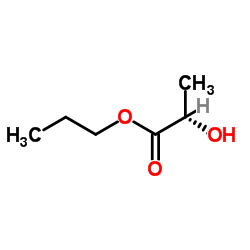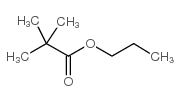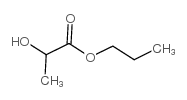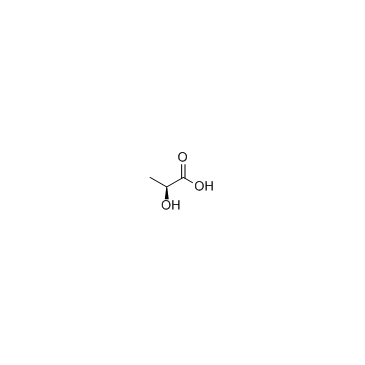53651-69-7
| Name | (S)-Propyl 2-hydroxypropanoate |
|---|---|
| Synonyms |
Propyl (2S)-2-hydroxypropanoate
Propyl (S)-2-hydroxypropanoate Propyl (S)-(-)-lactate QY1&VO3 &&(S)-(-)- Form Propanoic acid, 2-hydroxy-, propyl ester, (2S)- MFCD06658964 |
| Density | 1.0±0.1 g/cm3 |
|---|---|
| Boiling Point | 174.2±8.0 °C at 760 mmHg |
| Melting Point | -14ºC |
| Molecular Formula | C6H12O3 |
| Molecular Weight | 132.158 |
| Flash Point | 62.7±6.4 °C |
| Exact Mass | 132.078644 |
| PSA | 46.53000 |
| LogP | 0.34 |
| Vapour Pressure | 0.4±0.7 mmHg at 25°C |
| Index of Refraction | 1.427 |
Synonym: Section 2 - COMPOSITION, INFORMATION ON INGREDIENTS
Risk Phrases: 37 41 66 Section 3 - HAZARDS IDENTIFICATION EMERGENCY OVERVIEW
Irritating to respiratory system. Risk of serious damage to eyes. Repeated exposure may cause skin dryness or cracking. Potential Health Effects Eye: Risk of serious damage to eyes. Skin: May cause skin irritation. May be harmful if absorbed through the skin. Ingestion: May cause irritation of the digestive tract. May be harmful if swallowed. Inhalation: Causes respiratory tract irritation. May be harmful if inhaled. Chronic: Not available. Section 4 - FIRST AID MEASURES Eyes: Flush eyes with plenty of water for at least 15 minutes, occasionally lifting the upper and lower eyelids. Get medical aid. Skin: Get medical aid. Flush skin with plenty of water for at least 15 minutes while removing contaminated clothing and shoes. Ingestion: Get medical aid. Wash mouth out with water. Inhalation: Remove from exposure and move to fresh air immediately. If not breathing, give artificial respiration. If breathing is difficult, give oxygen. Get medical aid. Notes to Physician: Treat symptomatically and supportively. Section 5 - FIRE FIGHTING MEASURES General Information: As in any fire, wear a self-contained breathing apparatus in pressure-demand, MSHA/NIOSH (approved or equivalent), and full protective gear. Extinguishing Media: Use water spray, dry chemical, carbon dioxide, or chemical foam. Section 6 - ACCIDENTAL RELEASE MEASURES General Information: Use proper personal protective equipment as indicated in Section 8. Spills/Leaks: Absorb spill with inert material (e.g. vermiculite, sand or earth), then place in suitable container. Section 7 - HANDLING and STORAGE Handling: Avoid breathing dust, vapor, mist, or gas. Avoid contact with skin and eyes. Storage: Store in a cool, dry place. Store in a tightly closed container. Keep under a nitrogen blanket. Section 8 - EXPOSURE CONTROLS, PERSONAL PROTECTION Engineering Controls: Facilities storing or utilizing this material should be equipped with an eyewash facility and a safety shower. Use adequate ventilation to keep airborne concentrations low. Exposure Limits CAS# 53651-69-7: Personal Protective Equipment Eyes: Not available. Skin: Wear appropriate protective gloves to prevent skin exposure. Clothing: Wear appropriate protective clothing to prevent skin exposure. Respirators: Follow the OSHA respirator regulations found in 29 CFR 1910.134 or European Standard EN 149. Use a NIOSH/MSHA or European Standard EN 149 approved respirator if exposure limits are exceeded or if irritation or other symptoms are experienced. Section 9 - PHYSICAL AND CHEMICAL PROPERTIES Physical State: Liquid Color: colorless Odor: Not available. pH: Not available. Vapor Pressure: 1.1mbar @20 deg C Viscosity: 3.3 mPa.s @20 deg C Boiling Point: 170 deg C Freezing/Melting Point: -14 deg C Autoignition Temperature: 390 deg C ( 734.00 deg F) Flash Point: 69 deg C ( 156.20 deg F) Explosion Limits, lower: Not available. Explosion Limits, upper: Not available. Decomposition Temperature: >170 deg C Solubility in water: completely miscible Specific Gravity/Density: 1.000 Molecular Formula: C6H12O3 Molecular Weight: 132.16 Section 10 - STABILITY AND REACTIVITY Chemical Stability: Stable under normal temperatures and pressures. Conditions to Avoid: Incompatible materials. Incompatibilities with Other Materials: Strong oxidizing agents, acids, bases, water. Hazardous Decomposition Products: Carbon monoxide, carbon dioxide. Hazardous Polymerization: Has not been reported. Section 11 - TOXICOLOGICAL INFORMATION RTECS#: CAS# 53651-69-7 unlisted. LD50/LC50: Not available. Carcinogenicity: Propyl (S)-(-)-lactate - Not listed by ACGIH, IARC, or NTP. Section 12 - ECOLOGICAL INFORMATION Ecotoxicity: Log Pow: 0.51 Section 13 - DISPOSAL CONSIDERATIONS Dispose of in a manner consistent with federal, state, and local regulations. Section 14 - TRANSPORT INFORMATION IATA Not regulated as a hazardous material. IMO Not regulated as a hazardous material. RID/ADR Not regulated as a hazardous material. Section 15 - REGULATORY INFORMATION European/International Regulations European Labeling in Accordance with EC Directives Hazard Symbols: XI Risk Phrases: R 37 Irritating to respiratory system. R 41 Risk of serious damage to eyes. R 66 Repeated exposure may cause skin dryness or cracking. Safety Phrases: S 26 In case of contact with eyes, rinse immediately with plenty of water and seek medical advice. S 39 Wear eye/face protection. WGK (Water Danger/Protection) CAS# 53651-69-7: No information available. Canada CAS# 53651-69-7 is listed on Canada's NDSL List. CAS# 53651-69-7 is not listed on Canada's Ingredient Disclosure List. US FEDERAL TSCA CAS# 53651-69-7 is listed on the TSCA inventory. SECTION 16 - ADDITIONAL INFORMATION N/A |
| Hazard Codes | Xi: Irritant; |
|---|---|
| Risk Phrases | R66 |
| Safety Phrases | 39-26 |
| HS Code | 2918110000 |
|
~% 
53651-69-7 |
| Literature: Tetrahedron Asymmetry, , vol. 4, # 10 p. 2219 - 2228 |
| Precursor 1 | |
|---|---|
| DownStream 1 | |
| HS Code | 2918110000 |
|---|---|
| Summary | 2918110000. lactic acid, its salts and esters. VAT:17.0%. Tax rebate rate:13.0%. Supervision conditions:AB(certificate of inspection for goods inward,certificate of inspection for goods outward). MFN tariff:6.5%. General tariff:30.0% |


